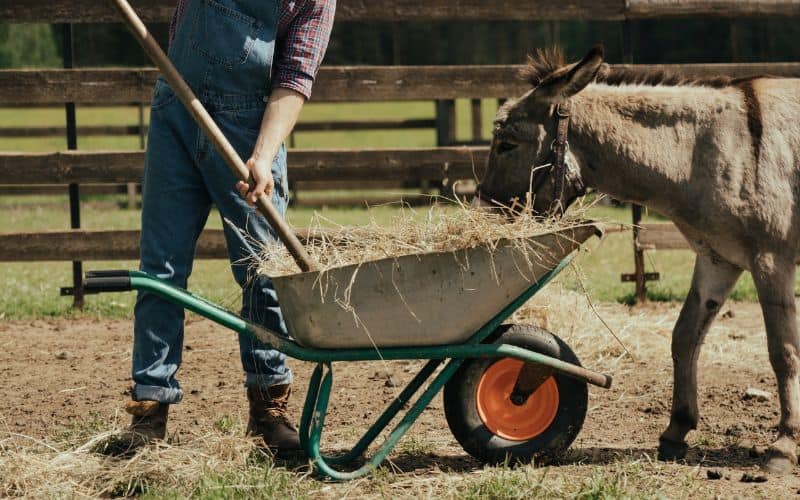The Abyssinian donkey, also known as the Ethiopian donkey (Equus Asinus Africanus), is a species native to Africa. These donkeys are most widespread in Ethiopia, although you can also encounter them in other African countries, including Somalia and Eritrea.
Another common donkey species throughout Africa, known as the domestic donkey (Equus Asinus) derives from the Abyssinian donkey. Many see these donkeys as the same species, meaning they are all considered Abyssinian donkeys by many people, which can cause some confusion.
Abyssinian donkeys are between 30 and 40 high and can weigh up to 4,500 pounds. They also have long lifespans and can live up to 40 years. Their bodies are typically gray, with white bellies and striped legs (Equus Asinus Africanus). However, some Ethiopian donkeys are chestnut brown.
Keep reading to learn more about this interesting donkey species.

Quick Facts About the Abyssinian Donkey
| Breed Name: | Abyssinian Donkey, Ethiopian donkey |
| Place of Origin: | Ethiopia |
| Uses: | Transportation, farming |
| Jack (Male) Size: | Up to 40 inches, 190–450 pounds |
| Jenny (Female) Size: | Up to 40 inches 190–400 pounds |
| Color: | Gray, chestnut brown |
| Lifespan: | 30–40 years |
| Climate Tolerance: | Arid, hot |
| Care Level: | Low |
Abyssinian Donkey Origins
Abyssinian donkeys are native to Africa and can be found in Ethiopia, Somalia, and Eritrea deserts. They were formerly common in Sudan, Egypt, and Libya but have since become rare in these areas. They are adapted to living in hot conditions and can regulate their body temperature when needed.
Unfortunately, Abyssinian donkeys are rare and in the wild are considered an endangered species, which is why their preservation is crucial to help prevent extinction.

Abyssinian Donkey Characteristics
Like most donkeys, Abyssinian donkeys are active animals, although they prefer to rest during the day.
While most donkeys flee when they sense danger, Abyssinian donkeys are curious and won’t run when threatened. Instead, they’ll investigate the situation, assess it carefully, and decide what to do next. These donkeys can run quite quickly, though, with a top speed of over 43 miles per hour, so they can escape if the danger is real.
These donkeys commonly feed on grass, leaves, and bark.
Abyssinian Donkey Uses
The Abyssinian donkey is mostly used in agriculture and transportation and is highly adapted to the hot, arid regions of their origins. These hardy animals can survive even if they lose up to 30% of their body weight in water. This is similar to camels, but Abyssinian donkeys can’t spend too much time without water—they need to drink at least once every 2 to 3 days.
While they must regenerate their body water levels regularly, they don’t need much water and can replenish the lost water in 2 to 5 minutes.

Abyssinian Donkey Appearance & Varieties
Abyssinian donkeys are typically completely gray, although some have white bellies and striped legs. Some Ethiopian donkeys and crosses are chestnut brown.
This species’ males and females are similar, although the males are heavier and taller than the females. Both genders are mature and ready to get a partner at the age of 2. There’s no specific time frame when Abyssinian donkeys breed, but they frequently prefer the rainy season. The female carries the baby donkey for 12 months, and the offspring are fairly independent from the moment they’re born.
Population/Distribution/Habitat
Many people haven’t heard of the Abyssinian donkeys, and that’s mostly because wild populations of this donkey species are critically endangered. There are approximately 1,000 of these donkeys in the world, so preserving them is crucial. Unfortunately, when in the wilderness, they face a lot of predators, and it’s not uncommon for people to hunt them, which puts them in more danger.
While donkeys generally have long lifespans, Abyssinian donkeys stand out as they can live over 40 years in captivity. Unfortunately, their lifespans in the wilderness are typically much lower due to the predators and people that hunt them.
Are Abyssinian Donkeys Good for Small Scale-Farming?
In general, donkeys are a great addition to any small-scale farm, and the Abyssinian is no different. Since these animals can tolerate heat so well, can carry heavy loads, and are exceedingly hardy, they are a great choice for both farming and transportation, in which they have widely been used for centuries.

Conclusion
Many people are unfamiliar with this donkey species, especially considering how rare it is. There are only around 1,000 representatives left, so learning more about these lovely donkeys is essential for their preservation.
Featured Image Credit: TFoxFoto, Shutterstock
